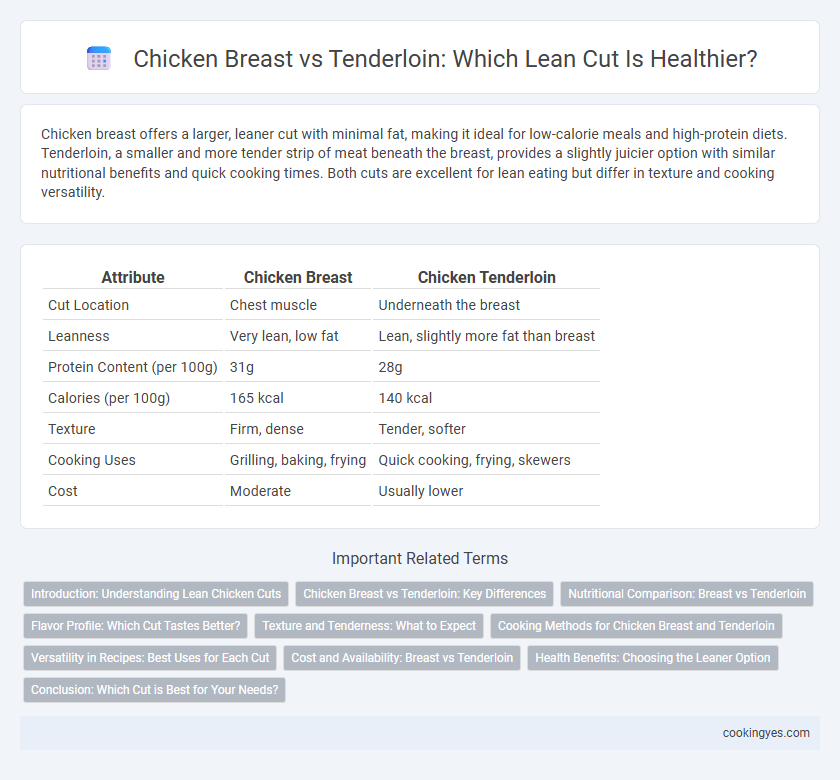Chicken breast offers a larger, leaner cut with minimal fat, making it ideal for low-calorie meals and high-protein diets. Tenderloin, a smaller and more tender strip of meat beneath the breast, provides a slightly juicier option with similar nutritional benefits and quick cooking times. Both cuts are excellent for lean eating but differ in texture and cooking versatility.
Table of Comparison
| Attribute | Chicken Breast | Chicken Tenderloin |
|---|---|---|
| Cut Location | Chest muscle | Underneath the breast |
| Leanness | Very lean, low fat | Lean, slightly more fat than breast |
| Protein Content (per 100g) | 31g | 28g |
| Calories (per 100g) | 165 kcal | 140 kcal |
| Texture | Firm, dense | Tender, softer |
| Cooking Uses | Grilling, baking, frying | Quick cooking, frying, skewers |
| Cost | Moderate | Usually lower |
Introduction: Understanding Lean Chicken Cuts
Chicken breast and tenderloin are both popular lean cuts prized for their high protein content and low fat levels. Breast meat, taken from the chest, is larger and slightly drier, making it ideal for grilling and baking with minimal added fat. Tenderloin, a smaller strip beneath the breast, is more tender and cooks quickly, offering a moist texture while maintaining lean nutritional benefits.
Chicken Breast vs Tenderloin: Key Differences
Chicken breast is a lean cut with lower fat content, offering a firm texture ideal for grilling and baking, while tenderloin, located beneath the breast, is even more tender and slightly higher in fat. Nutritionally, chicken breast provides more protein per serving, making it a preferred option for muscle building and weight management. Tenderloin's delicate texture makes it perfect for quick cooking methods like sauteing, highlighting subtle flavor differences in lean poultry cuts.
Nutritional Comparison: Breast vs Tenderloin
Chicken breast offers a higher protein content with approximately 31 grams per 100 grams, making it ideal for muscle building and weight management. Chicken tenderloin contains slightly fewer calories and less fat, with about 3 grams of fat per 100 grams compared to breast's 3.6 grams, supporting leaner dietary goals. Both cuts provide essential vitamins like niacin and B6 but breast generally has a marginally richer nutrient profile, beneficial for overall health and fitness.
Flavor Profile: Which Cut Tastes Better?
Chicken breast offers a mild flavor with a firm texture, making it versatile for various recipes, while tenderloin delivers a slightly sweeter, more delicate taste due to its higher fat content and tenderness. The tenderloin's subtle richness enhances flavor absorption from marinades and spices, providing a juicier eating experience compared to the lean, drier breast. For those prioritizing flavor, tenderloin often tastes better due to its balance of tenderness and natural savory notes.
Texture and Tenderness: What to Expect
Chicken breast offers a firm texture with a mild flavor, making it versatile for various recipes but can become dry if overcooked. Tenderloin, located under the breast, is inherently more tender and juicy due to its smaller muscle fibers and lower connective tissue. Expect tenderloin to deliver a softer, more delicate bite, ideal for quick-cooking methods that preserve moisture and tenderness.
Cooking Methods for Chicken Breast and Tenderloin
Chicken breast and tenderloin are both lean cuts prized for their high protein content and low fat. Chicken breasts are ideal for grilling, baking, or poaching due to their larger size, which requires careful cooking to prevent dryness. Tenderloins, being smaller and more delicate, cook quickly and excel when sauteed or stir-fried, retaining tenderness and moisture.
Versatility in Recipes: Best Uses for Each Cut
Chicken breast offers a versatile option for a wide range of recipes, lending itself well to grilling, baking, and sauteing due to its firm texture and ability to hold marinades. Tenderloin, being more tender and thin, excels in quick-cooking dishes like stir-fries, fajitas, and breaded chicken strips, providing a juicy bite with minimal cooking time. Both cuts are lean and protein-rich, but choosing between breast and tenderloin depends on the desired cooking method and dish complexity.
Cost and Availability: Breast vs Tenderloin
Chicken breast is typically more affordable and widely available in most grocery stores due to its larger size and higher demand. Tenderloin, being a smaller, more delicate cut located beneath the breast, is often priced higher and less commonly found in standard retail outlets. The cost difference reflects the tenderness and cooking versatility of tenderloins, but chicken breast remains the preferred lean cut for budget-conscious consumers.
Health Benefits: Choosing the Leaner Option
Chicken breast offers a leaner protein option with lower fat content compared to the tenderloin, making it ideal for health-conscious diets. Rich in essential amino acids and low in saturated fat, chicken breast supports muscle growth and weight management. Tenderloin, while tender and flavorful, contains slightly higher fat levels but still serves as a nutritious lean cut suitable for balanced meals.
Conclusion: Which Cut is Best for Your Needs?
Chicken breast offers a leaner option with higher protein content and lower fat, making it ideal for calorie-conscious diets and muscle building. Tenderloin provides a more tender texture with slightly higher fat, suitable for recipes requiring juicier, more flavorful meat. Choose breast for maximum leanness and tenderloin for enhanced taste and moisture.
Breast vs Tenderloin for lean cuts Infographic

 cookingyes.com
cookingyes.com